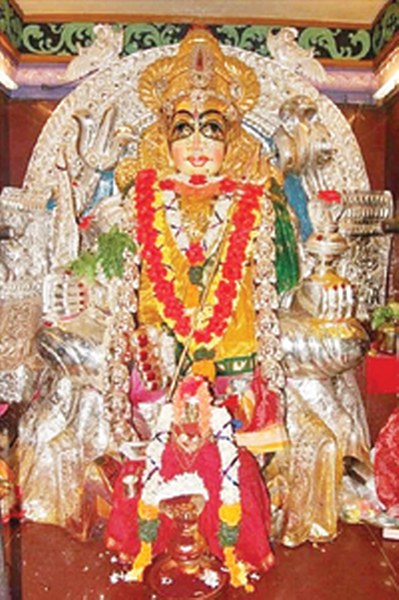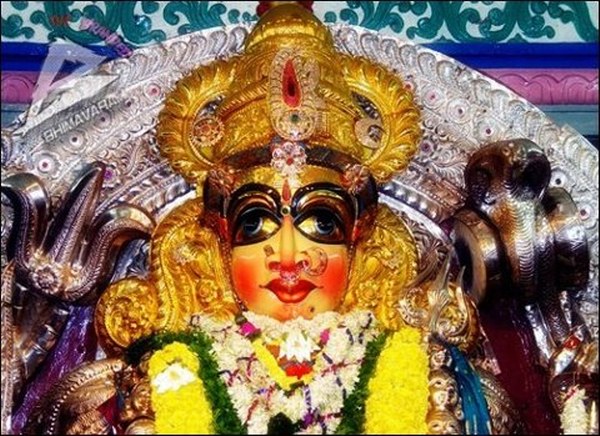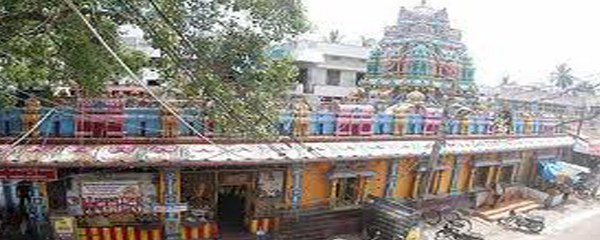 Sri Sri Sri Jaganmatha Mavullamma ammavaru: Protector of people from evil spirits. It is believed Jaganmatha (Universal Mother goddess) Sri Mavullamma ammavaru (Mother goddess) is the incarnation of Mahakali (the goddess of Shakthi-Power) in olden days. she is in a midst of mango groves. So she is called 'Mavullamma' (Mamidi is local tongue to Mango). It is believed that neighbour villagers treated her as their own villages mother goddess, So she is addressed as 'Mavullamma' (Mother goddess of my own village).
Sri Sri Sri Jaganmatha Mavullamma ammavaru: Protector of people from evil spirits. It is believed Jaganmatha (Universal Mother goddess) Sri Mavullamma ammavaru (Mother goddess) is the incarnation of Mahakali (the goddess of Shakthi-Power) in olden days. she is in a midst of mango groves. So she is called 'Mavullamma' (Mamidi is local tongue to Mango). It is believed that neighbour villagers treated her as their own villages mother goddess, So she is addressed as 'Mavullamma' (Mother goddess of my own village).
The temple history of Jaganmatha Sri Mavullamma came to limelight in the year 1880 AD, Since then only the temple history is available to us. It is believed that she is laid in Motupallivari street, under couple of pipal and Neem tree. Every year in the month of "Jyesta masa" (third month of auspicious Telugu almanac calendar) on "Paadyami" (new slender crescent moon day). Devotees (worshippers) celebrates one month long celebration in this month. There is a festive look every where in and around the town. The Devastanam (Temple committee) and local fruit and vegetable trader's committee felicitates artists, actors, actresses, musicians, great men of all walks of the life.
In 1910 AD floods the Mulavirat (Statue of Mavullamma) partially damaged. Later reinstates by great artist, sculptor Sri Grandhi Narasanna's son Sri Grandhi Appa Rao. He carved the Mulavirat (Mavullamma Statue) from ferocious stature to pleasant present peace form.There are many sayings of how Sri Sri Mavullamma Ammavaru emerged in Bhimavaram. One saying states that the goddess had emerged at Rayakuduru village near Veeravasaram. But according to the local people beliefs the history of Sri Sri Mavullamma Goddess is as follows.
It is said that the goddess had emerged during the period of 1200 A.D. But as per the temple point, the history is available only from the period of 1880 A.D. In Bhimavaram a place presently called as Motupalli Veedhi is  said to be the place where the goddess had emerged. Sri Mavullamma ammavaru emerged in a place where Neem and Peepal (vepa) trees were together.
said to be the place where the goddess had emerged. Sri Mavullamma ammavaru emerged in a place where Neem and Peepal (vepa) trees were together.
As the goddess had emerged in this place and as this place is rich for mango trees the Goddess had been named “MAMILLA AMMA” and later on during the days it had converted into “Sri MAVULLAMMA”. Another saying about the name is that as there are many small villages nearby Bhimavaram and they used to come to Bhimavaram to pray the Goddess as their Grama Devata the name “MAA VULLAMMA” had been incarnated.
EXCLUSIVE and Rare Photograph of Sri Mavullamma Ammavaru nearly 25 Years Back

During Vaishaka masam of the year 1880 A.D. Sri Mavullamma ammavaru came into the dream o f Sri Marella Machi Raju and Sri Grandhi Appanna and advised them to build a temple in the place where she had emerged. After they found the Goddess they used to offer her prayers in a small hut. Both Sri Marella Machi Raju and Sri Grandhi Appanna built the temple at the Sunday Market (Previously known as Aidhu Lanterla Stambham). During 1910 A.D. a sculptor Tatavolu Naga Bhushanacharyulu from Kaalla village incarnated the idol of the Goddess as SHANTI SWAROOPINI and placed Rama Krishna Paramahamsa and Vivekananda idols on the both sides of the entrance.
Sri Mavullamma Ammavaru as Sakambhari decorated with more than 25 kinds of Vegetables during Festivals
Mavullamma Utsavams are conducted every year in a very Grand way for nearly 50 days during Sankranthi season. Lightings and Decorations are put out throughout the Temple Premises
Conveyance: The temple is located in Motupalli vari street, Bheemavaram. Many Buses,Trains run from all cities and districts to reach Bheemavaram.Bheemavaram was approx 90KM from Elluru.
Notorious:
- Goddess decorated with large amounts of Gold ornaments(24 kgs of gold and 274 kgs of Silver) with 65 kgs of gold saree.
- Ramakrishna Paramahamsa and Gowthama Budha seated beside Goddess.
- Grand yearly celebrations in mid January.
- Free food donations and prasadam. No entrance fee.
Mother of wealth:
Prathah kala puja,Balabhoga nivedhana,Sahasra Kumkumarchana , Pancha harathi,Samuhika Sahasranamarchana,Vedha parayanam were done everyday. Free entrance to temple, there is no ticket or fee to view Goddess.
The temple is in an area of 13 cents. In this area there exist Prasada shala,Kotikala Govinda Rao Kalavedhika,Temple office. Pulihora Prasadam was given to all devotees for free of charge.Nityaannadanam was running for people who travel from far places to see Goddess.Goddess was decorated as Shakambari in Shudha Pournami of ashada month. Village fair was done in jyesta Month. At the time of Navaratri Goddess will be decorated in different incarnations and Laksha kumkuma archana and chandi homam will be conducted. Temple gains around 2 crores of money from Hundi, Coconut and Gifted sarees. Goddess have 24 kgs of gold and 274 kgs of silvers as ornaments and vessels.
Every year January 13th, annual celebrations were conducted by devasthanam with the support of Onion and fruits ,vegitable merchants. In the presence of Vutsava Committee 40 days celebrations were done by spending lakhs of money. Cultural activites were conducted.Electrical lighting is another specialattraction.Last 8 days of celebrations goddess was decorated as ashta lakshmi avatars. Food donation is conducted for devotees.
In January 2012, the goddess was decorated with a gold saree of 65 kgs and ornaments. The estimated cost of 20 crores were collected by “Swarna vastra nidhi Sangam”. Goddess have Trisula and damarukam made of 16 kgs gold. And also, having a gold crown (head ornament).Every year Suddha Pornami in the month Magha, mandal deeksha was carried by devotees for 40 days.Mandal Deeksha was started in 2010.